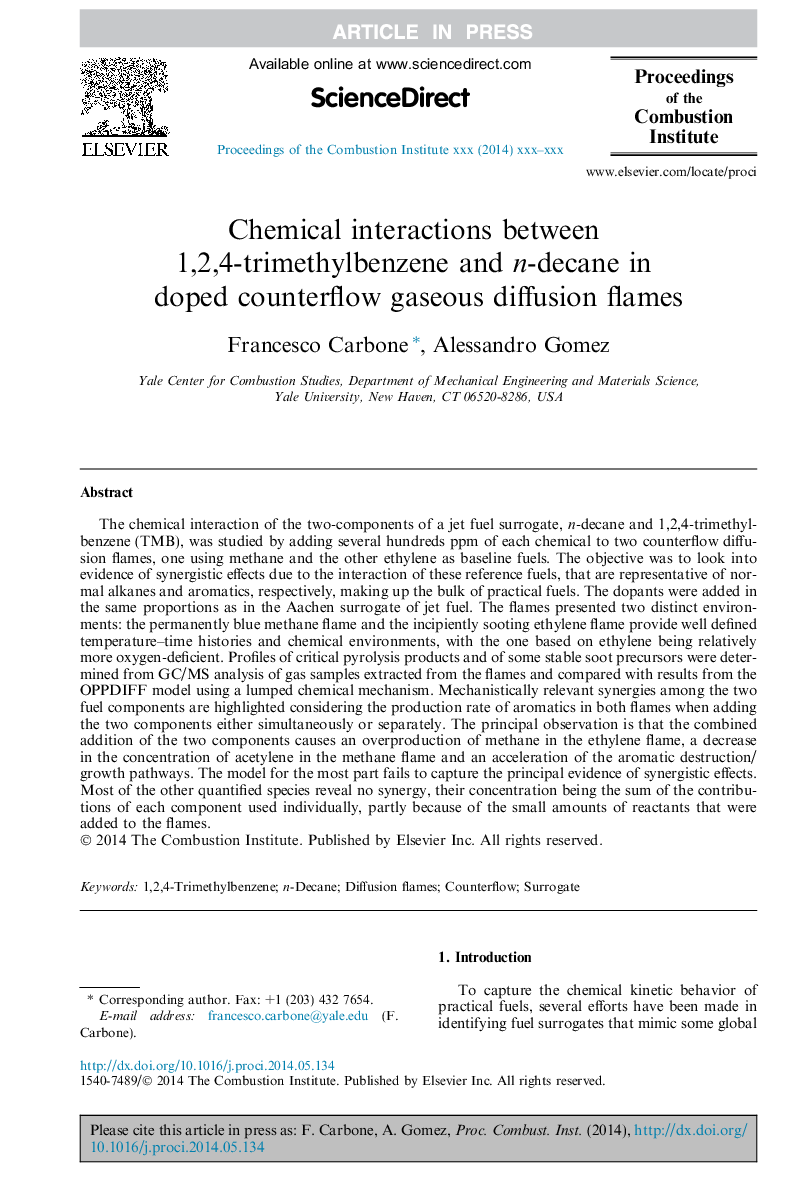| کد مقاله | کد نشریه | سال انتشار | مقاله انگلیسی | نسخه تمام متن |
|---|---|---|---|---|
| 6679364 | 1427921 | 2015 | 9 صفحه PDF | دانلود رایگان |
عنوان انگلیسی مقاله ISI
Chemical interactions between 1,2,4-trimethylbenzene and n-decane in doped counterflow gaseous diffusion flames
دانلود مقاله + سفارش ترجمه
دانلود مقاله ISI انگلیسی
رایگان برای ایرانیان
کلمات کلیدی
موضوعات مرتبط
مهندسی و علوم پایه
مهندسی شیمی
مهندسی شیمی (عمومی)
پیش نمایش صفحه اول مقاله

چکیده انگلیسی
The chemical interaction of the two-components of a jet fuel surrogate, n-decane and 1,2,4-trimethylbenzene (TMB), was studied by adding several hundreds ppm of each chemical to two counterflow diffusion flames, one using methane and the other ethylene as baseline fuels. The objective was to look into evidence of synergistic effects due to the interaction of these reference fuels, that are representative of normal alkanes and aromatics, respectively, making up the bulk of practical fuels. The dopants were added in the same proportions as in the Aachen surrogate of jet fuel. The flames presented two distinct environments: the permanently blue methane flame and the incipiently sooting ethylene flame provide well defined temperature-time histories and chemical environments, with the one based on ethylene being relatively more oxygen-deficient. Profiles of critical pyrolysis products and of some stable soot precursors were determined from GC/MS analysis of gas samples extracted from the flames and compared with results from the OPPDIFF model using a lumped chemical mechanism. Mechanistically relevant synergies among the two fuel components are highlighted considering the production rate of aromatics in both flames when adding the two components either simultaneously or separately. The principal observation is that the combined addition of the two components causes an overproduction of methane in the ethylene flame, a decrease in the concentration of acetylene in the methane flame and an acceleration of the aromatic destruction/growth pathways. The model for the most part fails to capture the principal evidence of synergistic effects. Most of the other quantified species reveal no synergy, their concentration being the sum of the contributions of each component used individually, partly because of the small amounts of reactants that were added to the flames.
ناشر
Database: Elsevier - ScienceDirect (ساینس دایرکت)
Journal: Proceedings of the Combustion Institute - Volume 35, Issue 1, 2015, Pages 761-769
Journal: Proceedings of the Combustion Institute - Volume 35, Issue 1, 2015, Pages 761-769
نویسندگان
Francesco Carbone, Alessandro Gomez,